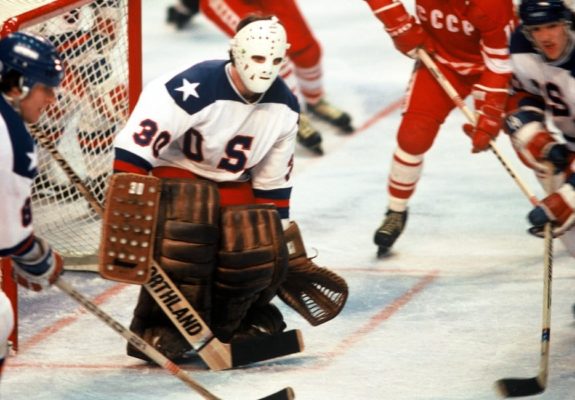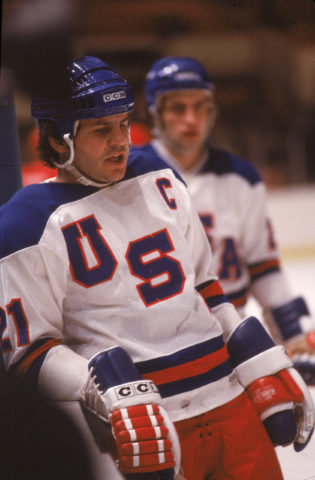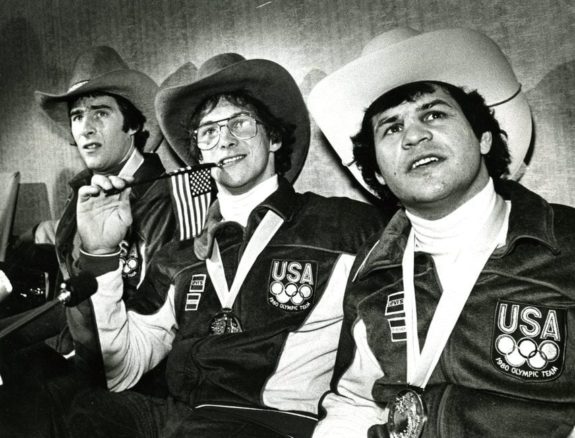In the 2004 film, “Miracle,” Kurt Russell, who plays Herb Brooks, talked about the best moment of the 1980 Olympics experience, and he refers to the team gathering together on the podium saying, “Well it was here. The sight of twenty young men with such differing backgrounds, now standing as one. Young men willing to sacrifice so much of themselves all for an unknown.”
Forty years later, this victory remains one of the most memorable moments in sports history, and the members of this team have gone on to accomplish an array of things in a variety of sectors. Some went on to play hockey professionally. Others went back to school and pursued different careers. Some have retired, and others have left us far too soon.
Related: Winter Olympics – Memories from the NHL Era
These are the stories of the men who created the “Miracle on Ice.”
Herb Brooks
Brooks played for the University of Minnesota and was part of the 1960 Olympic hockey team. As head coach, he led the 1980 Olympic team to a gold medal and won the Wayne Gretzky International Award after his death in 2003. The film “Miracle,” was dedicated to Brooks and reads, “He never saw it. He lived it.”
Bill Baker
Baker (defenseman) attended the University of Minnesota, serving as captain for the 1978-79 season. As part of the 1980 U.S. Olympic Team, his goal tied a game with Sweden, which advanced the U.S. to the medal round.
After playing hockey, he became an oral surgeon and retired a few years ago. Today, his jersey resides in the Smithsonian in Washington D.C.
Neal Broten
Broten (center) played for the University of Minnesota before playing for the 1980 Olympic team. He has won an NCAA championship, an Olympic gold medal, and a Stanley Cup. In 2000, he was inducted into the U.S. Hockey Hall of Fame. Today, he lives in River Falls, Wisconsin, and his nephew was drafted by the Washington Capitals in 2014.
Dave Christian
Christian (right wing) was born in Minnesota and ended up playing for the University of North Dakota in Grand Forks. Hockey clearly runs in the family; his dad Bill and his uncle Roger were part of the 1960 U.S. Olympic hockey team. Dave now works as a technician for Cardinal Glass Industries in North Dakota.
Steve Christoff
Christoff (forward) played for Herb Brooks in 1979, and then went on to score a goal and assist on another in the 1980 Olympic game against Finland to win the gold medal. He also ended up being the model for the Hobey Baker Award trophy, given to the NCAA hockey player who exhibits strong character on and off the ice. Today, he works as an airline pilot in Minnesota.
Jim Craig
Craig (goalie) was born in Easton, Massachusetts, and blocked 36 out of 39 shots in the Olympic game against the Soviet Union in 1980, in which the United States won 4-3.

He went on to play professionally for the Atlanta Flames, Boston Bruins and Minnesota North Stars. Today, Jim is the president and founder of Gold Medal Strategies, a marketing firm in Boston.

Mike Eruzione
Eruzione (left wing) was the captain of the 1980 U.S. hockey team and scored the winning goal against the Soviet Union. In 1999, Sports Illustrated selected that goal as the best moment in sports history of the 20th century.
Eruzione, or Rizzo, attended Boston University, was not drafted and ultimately decided not to play professionally. On Jan. 28, 2020, he released his book, “The Making of a Miracle,” published by Harper Collins.
John Harrington
Harrington (right wing) earned a walk-on spot at the University of Minnesota-Duluth and played four seasons for them. In the 1980 Olympics, Harrington assisted Eruzione in the game-winning goal against the Soviet Union, and after the Olympics, played for a variety of professional teams including the Oklahoma City Stars, Rochester Americans and Colorado Flames. Today, he is the head coach of women’s hockey at Minnesota State.
Steve Janaszak
Janaszack (goalie) was voted the most valuable player after the University of Minnesota won the NCAA championship in 1979. He was selected as the backup goalie to Jim Craig in the 1980 Olympics but didn’t end up having any ice time.
Related: 3 Legendary Olympic Hockey Players You’ve Never Heard Of
After the Olympics, he played for the Minnesota North Stars and Colorado Rockies before retiring in 1983. Today, he is an investment banker in New York.
Mark Johnson
Johnson (center) played for the University of Wisconsin-Madison for three seasons, coached by his father Bob Johnson. His second, and last-second, goal in the first period of the Olympic game against the Soviet Union led the head coach to remove Vladislav Tretiak (who was considered the best in the world at the time) from the goal.
Johnson went on to play for the Pittsburgh Penguins and St. Louis Blues among other professional teams and coached the U.S. national women’s hockey team to a silver medal in Vancouver in 2010.
Rob McClanahan
McClanahan (left wing) scored the winning goal against Finland in the Olympics, and his argument with coach Herb Brooks about playing through injury, is now extremely well-known, thanks to the 2004 movie, “Miracle.”
After playing for a few teams in the AHL and NHL, McClanahan became a financial broker, and today, he is the head hockey coach of The Blake School in Minnesota.
Ken Morrow
Morrow (defense) was part of Team USA at the 1978 Ice Hockey World Championship. After the Olympics, he was drafted by the New York Islanders and helped them win a Stanley Cup in 1980, which made him the first player to win a gold medal and a Stanley Cup in one season. Knee problems forced him to retire early, after the 1989-90 season. Today, he is a director of Pro Scouting for the Islanders.
Jack O’Callahan
O’Callahan (defense) joined the Olympic team a year after graduating from Boston University, where he served as captain for two seasons. A knee injury kept OC out of the Olympic opening game against Sweden, but he was back on the ice for the game against the Soviet Union.

In 1977, he was drafted by the Chicago Blackhawks and went to play for them after the Olympics, later playing for the New Jersey Devils. Today, he is a director at an asset management company centered in Chicago.
Mark Pavelich
Pavelich (center) had two assists in the game against the Soviet Union, and after the Olympics went on to play for the New York Rangers, where he still holds the record for most points scored as a rookie. Today, there are concerns that he is dealing with brain trauma and mental illness, and as of December, a county district judge sent him to a treatment facility.
Mike Ramsey
Ramsey (defense) was the youngest member of the Olympic team and had been named the top high school hockey player in Minnesota in 1977-78. After the Olympics, he was drafted by the Buffalo Sabres and ended up playing 14 seasons for them.
After retiring in 1996, he was an assistant coach for the Sabres and then the Minnesota Wild before co-founding a hedge-fund. Today, he’s retired in Minnesota.
Buzz Schneider
Schneider (left wing), whose real name is William, earned the nickname “Buzz” because it resembles the Croatian word for brother. He was part of the 1976 Olympic team, and he was part of the “Conehead” lineup in 1980 with Mark Pavelich and John Harrington. Today, he works in commercial real estate.
Dave Silk
Silk (right wing) attended Boston University and played with future Olympic teammates Jim Craig, Jack O’Callahan and Mike Eruzione. He was drafted by the New York Rangers in 1978 and went on to play for the Boston Bruins and Detroit Red Wings among other teams, before returning to BU as an assistant coach in 1991. Today, he is the director of Standard Life Investments in Boston.
Eric Strobel
Strobel (right wing) played for Team USA in the Ice Hockey World Championship in Moscow in 1979 and was drafted 133rd overall by the Sabres in 1978. He retired a couple of years later in 1980 after breaking his ankle. A minor stroke in 2006 prevents him from being on the ice, but after taking over the family business and volunteering as a youth hockey coach, he is happily retired in Minnesota.
Bob Suter
Suter (defense) played for the University of Wisconsin-Madison and is well-known for setting records for penalty minutes. He was drafted by the Los Angeles Kings in 1977, but ultimately decided not to sign with them after the Olympics, and he never ended up playing a game in the NHL.
In Sept. 2014, at a rink in Wisconsin, Suter died from a heart attack, and less than a year after his death, the rink was renamed in his honor. His son, Ryan Suter is the alternate captain for the Minnesota Wild and co-owner of the Madison Capitols.
Phil Verchota
Verchota (left wing) was recruited by the University of Minnesota for both football and hockey but chose hockey. After the 1980 Olympics, he opted to play for Finland instead of signing with the Minnesota North Stars, and eventually, he was selected as team captain of the 1984 U.S. Olympic hockey team.
Today, he works in banking in Minnesota, and his 1980 skates are on display at the Museum of Natural History.
Mark Wells
Wells (center) played for Bowling Green University and he and Ken Morrow (a BG teammate) were selected to play for the 1980 Olympic team. Wells bounced around from the Montreal Canadiens to the minor leagues but didn’t play a game in the NHL. After he retired from hockey, he learned he had spinal disease and dealt with several surgeries.
It’s been 40 years since that Olympic gold medal win, yet the pride and patriotism haven’t dimmed, as seen in the final moments of “Miracle,” which serves as a shining example of profound perseverance and athletic achievement. And as the men crowd the podium, Brooks captures the scene poignantly: “But on one weekend, as America and the world watched, a group of remarkable young men gave the nation what it needed most. A chance, for one night, not only to dream, but a chance, once again, to believe.”
